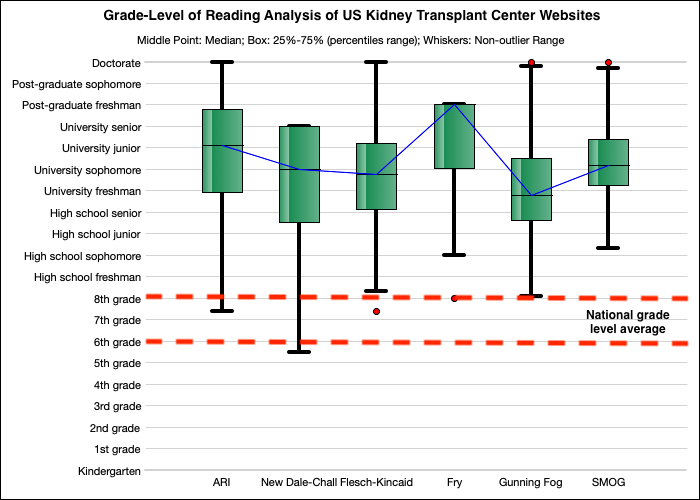Providing Equitable Access: Language and Literacy Levels of Kidney Transplant Center Websites
1University Of California – Riverside, School of Medicine, Riverside, CA, 2University of Michigan Medical School, Ann Arbor, MI, 3Department of Surgery, University of Michigan Health System, Ann Arbor, MI
Meeting: 2021 American Transplant Congress
Abstract number: 1271
Keywords: African-American, Donation, Hispanic, Kidney/pancreas transplantation
Topic: Clinical Science » Organ Inclusive » Non-Organ Specific: Disparities to Outcome and Access to Healthcare
Session Information
Session Name: Non-Organ Specific: Disparities to Outcome and Access to Healthcare
Session Type: Poster Abstract
Session Date & Time: None. Available on demand.
Location: Virtual
*Purpose: Health disparities exist for access to kidney transplantation. Accessibility of patient-facing transplant center resources can contribute to these disparities. Patients interact with transplant centers through multiple interfaces, with online websites being a frequently used resource. It is unknown if these websites provide equitable access to transplant center information. This study aimed to assess kidney transplant center website language and literacy levels.
*Methods: US kidney transplant center websites were evaluated for language accessibility. The readability and grade level of each website’s content was assessed using the following validated tests: New Dale-Chall, Flesch-Kincaid, Flesch Reading Ease, Fry, and Simple Measure of Gobbledygook (SMOG).
*Results: 227 kidney transplant centers’ websites were identified. 17% (38/227) provided alternative language resources. Region 4 (OK, TX) and 5 (AZ, CA, NV, NM, UT) provided the most resources (14/57), whereas region 8 (CO, IA, KS, MO, NE, WY) and 10 (IN, MI, OH) did not provide any (0/34). The average readability ease for all websites via the Flesch Reading Ease test was 38±12, ranging from 1 to 69 (0= most difficult to read, 100= easiest to read). The average grade level of reading required to understand online patient information across all kidney transplant websites was college-level education, despite the national U.S. literacy level being between 6th and 8th grade. These results were concordant across the additional tests performed.
*Conclusions: Less than 20% of kidney transplant center websites provided alternative language resources, which did not reflect their respective state demographics. Websites’ literacy levels are well above the national reading average. We hope to provide recommendations and guidelines to improve transplant center accessibility to patients who are non-English speaking or reading below the national literacy level.
To cite this abstract in AMA style:
Barrientos ROlmeda, Jacobson CE, Valbuena VS, Anderson MS, Englesbe MJ, Waits SA, Santos-Parker JR. Providing Equitable Access: Language and Literacy Levels of Kidney Transplant Center Websites [abstract]. Am J Transplant. 2021; 21 (suppl 3). https://atcmeetingabstracts.com/abstract/providing-equitable-access-language-and-literacy-levels-of-kidney-transplant-center-websites/. Accessed December 13, 2025.« Back to 2021 American Transplant Congress

